The Char-Baby
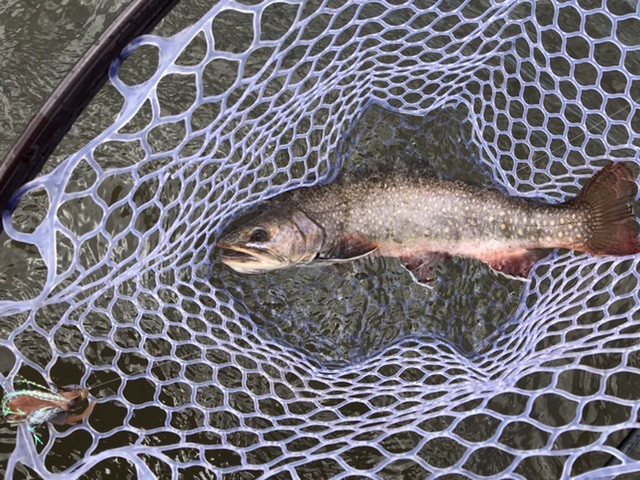
The Tar-Baby is an Uncle Remus story published in 1881; it’s about a doll made of tar and turpentine used by the villainous Br'er Fox to entrap Br'er Rabbit. The more that Br'er Rabbit fights the Tar-Baby, the more entangled he becomes. In modern usage, tar baby refers to a problematic situation that is only aggravated by additional involvement with it. (Wikipedia)
As I was driving out of the Andes away from Lago Fontana and onto the Argentine steppe, down a rough, dusty road trying to stay ahead of my own, giant dust cloud threatening to overtake the truck at 40 km per hour, I felt like Br’er Rabbit, realizing that my mild obsession with char had got me again.
I’ve always had a fascination with the various char species. Brook Trout were the first wild “trout” (char) species I’d caught with a fly rod back in the mid-70s. Arctic char was the first species of fish I caught in Alaska in 1988. When I became a Beaver seaplane pilot in the mid-90s I’d do exploratory trips at mountain lakes to catch Lake Trout.
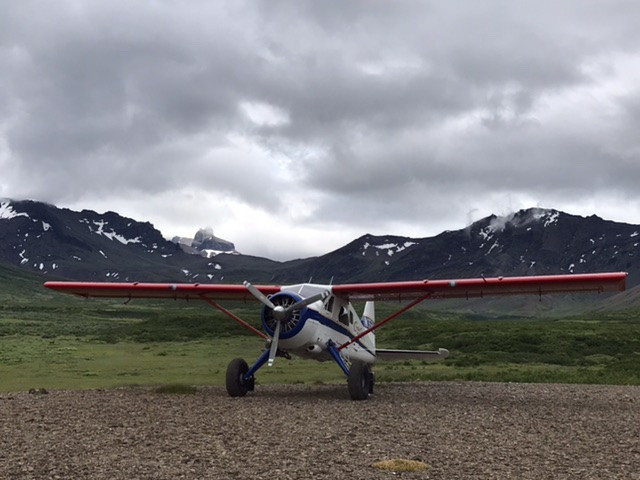
I now fly a Beaver on wheels. The best places for landing a wheel Beaver are the ancient glacier washes and volcanic cinder flats on the Alaska Peninsula south of Crystal Creek Lodge. The Peninsula is Dolly Varden and Arctic Char country. As if Rainbow Trout are hard to catch, I’m derisively referred to by the guides as the “Dolly Guide”. That’s OK with me.
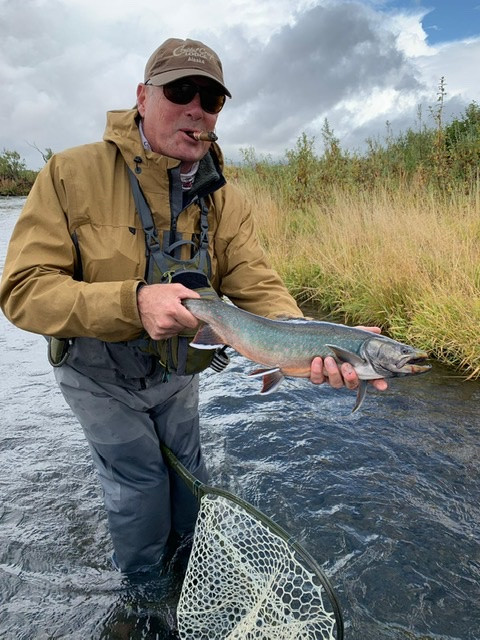
Dollies, I feel, are the most beautiful fish in Alaska as well as the toughest. Their semi-anadromous life strategy leaves me in awe. They, as well as the other char species, require cold, clean water to survive. Cold, clean water in either Alaska or the Andes is usually found high in the mountains; the most beautiful of country. But let’s get out of Alaska and back to Patagonia where this story is being written.
Before saying farewell to Troy at his cabin in Chile, he and I were discussing the best path to my next destination, Rio Pico in Argentina where I was to join Patagonia Drifters for a few days. Border crossings haven’t been much fun recently because of various Argentine customs agents giving Lynnette and I trouble about the truck paperwork at the busier frontier crossings. Accordingly, we’ve began seeking the most remote crossings possible. Troy suggested there was a very remote frontier crossing back into Argentina only 15 km from our present location. I checked my fuel & distances then dialed-in the GPS for Valle Verde and hit the road.
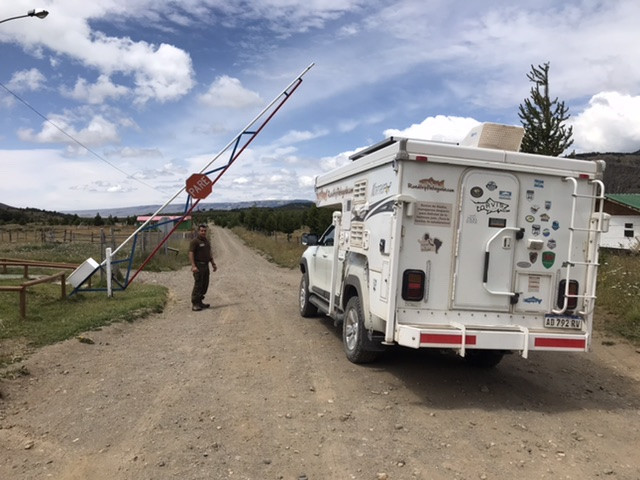
The Chilean frontier crossing was uneventful. While awaiting my turn in the tiny office I watched a sow and piglets playing just outside.
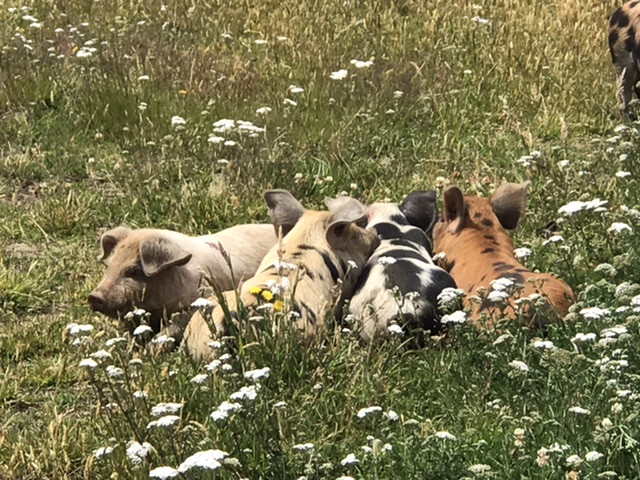
When my turn came, a very friendly Carbinero quickly processed the paperwork and waved me through. As is often the case at these remote crossings, there is a no-man’s land between the two countries. The 20 km drive gave me a little time to become apprehensive about being received by the Argentine agents. Upon reaching the Argentine post I came to a locked gate.
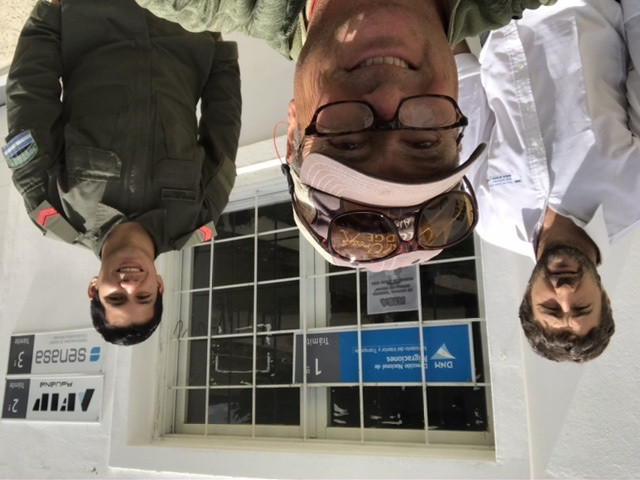
I parked and walked into a tiny, old stone building where an Argentine Gendarme and an Aduana agent sat watching sports on a giant TV upon the wall. They looked pretty bored, I thought, and here was I, a fresh prospect for scrutiny. I handed my passport and paperwork over to them. The Aduana agent amused himself by flipping through my passport for about five minutes, inspecting the various places I’d gone in the world over the past 15 years. The Gendarme took my paperwork given upon leaving Argentina two weeks previous and processed my re-entry. “Do you live in Argentina?” He asked me in Spanish. “Yes,” I replied in kind, “I have an apartment in Buenos Aires at 2653 Avenida Santa Fe”. I didn’t feel adding that the address was the office of my friend, Carlos, and that I considered his coat closet to be my apartment to be useful information at that moment.
The Aduana agent got very excited when he realized I was on an extended fishing vacation. “There are fontanelles (Brook Trout) in the lake about 15 km away!” he said in Spanish as he held his palms vertical about 24 inches apart. Again, the bait of potentially catching char was laid and I was mouthing it. “Where can I get provisions?” I asked. “10 km the other direction, then you can come back and go fishing in the lake!” Again, he held his palms in the 24-inch gesture. “There are some big ones in there!” he remarked. I was swallowing the bait by then.
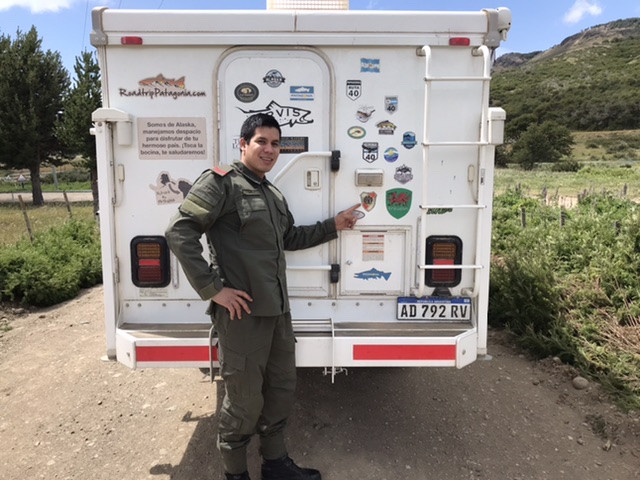
The young Gendarme walked me to the truck for what I assumed be an inspection. It turned out he just wanted to see the truck & invite me to go fishing with him when he was done with work in about three days. I thanked him profusely and declined, saying I had to keep moving. As I pulled away and they waved goodbye I thought: “Yep, remote border crossings are the way to go.”
Arriving into the tiny, windswept town of Aldea Beliero, everything was closed for siesta. Looking in the windows of the mini-markets, I saw there wasn’t much to buy there. Exploring the map on the GPS, I selected Alto Rio Senguer as the destination, pressed go, checked the mirrors and pulled-out into the dirt highway. I was immediately passed by a car with Argentinian plates that must’ve been in my blind spot. They flipped me the finger as they passed.
The Rio Senguer had come into our vision twice already on our adventure. One time, an Argentinian named Charly (providence?) who followed our photo account on Instagram private-messaged us and said we must visit the head water lake of the Rio Senquer El Lago Platte. He gave us a photo with explicit directions find his favorite fishing spots. On another turn, Jeremy Kehrein of Orvis travel had sent me an email, unsolicited, saying that we should fish the Rio Senquer for large Brook Trout. I’d pressed Jeremy for specifics. He then dug into his notes, 20 years old, and, again, laid out exact directions to the places he’d experienced the best fishing. The hook was set. All these indicators pointing to big char at El Rio Senquer and it lay in my path. How could I not go?
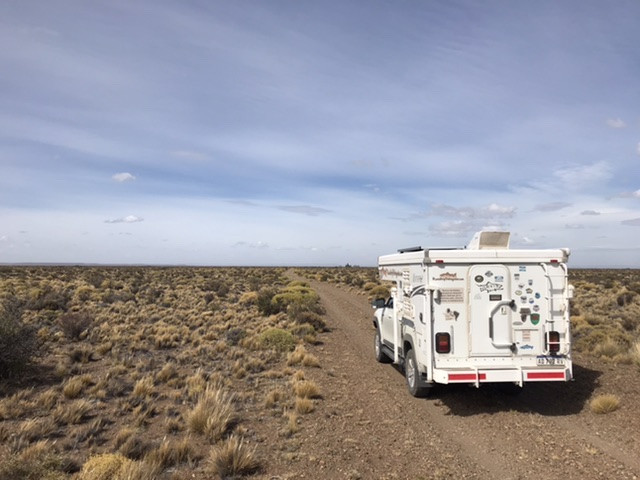
As I continued eastward, the wind at my back was very strong as it roared over the Andes from the Pacific and onto the Patagonian steppe. Very little pressure was required on the gas pedal and it seemed the truck was literally flying. I turned north onto an unpaved road and then eastward again as the GPS instructed. By the time I turned onto a two-track full of weeds the realization came that when the town of Alto Rio Senquer was punched-in the GPS was in ‘explore’ mode. ‘Explore’ mode on the Garman Overlander GPS means any road or trail, regardless of its condition, is fair-game for navigation.
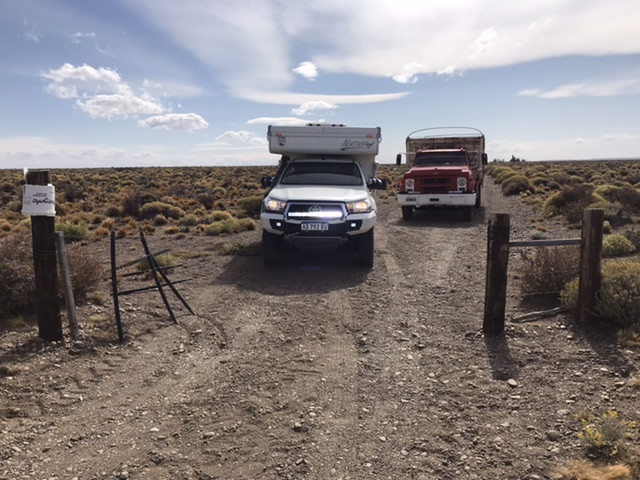
I started coming to fences and gates. Fortunately they were not locked, because I don’t think there’s many people desiring to trespass, for any reason, on that desolate, windswept place. Except the absent-minded gringo writing this story. I came across a party of gauchos in their truck moving along a fence in my direction. I told one I was lost, and sorry for being on their land attempting to make my way to Alto Rio Senquer. The gaucho cheerfully offered me directions, which I confirmed on the GPS, and opened the fence for me.
The already fierce wind at my back increased. I had to be extremely careful opening the truck door, holding on with both hands so the wind wouldn’t rip it off it’s hinges. Finding a suitable corner of the truck to take a pee was an adventure in itself, the details of which I leave to your imagination.
After pulling into the town of Alto Rio Senquer, I stopped for fuel at a YPF station. Diego, the owner, was extremely helpful and friendly. He helped with directions to several services. He allowed me to fill the camper with water. Seeing my camper full of fishing stickers, he get very excited and said the Rio Senquer had big trout in it as he held his palms 24 inches apart. Damn. There it was again. While the water tank filled he saw me looking at the iPhone. He said he had Internet and gave me the password. I told him I had some huge files to upload, and asked if it was OK to use his internet for the job. “No problem“, he said. I told him I would come back in the evening or early in the morning so his service would not be affected by my huge upload and wished him a good night.
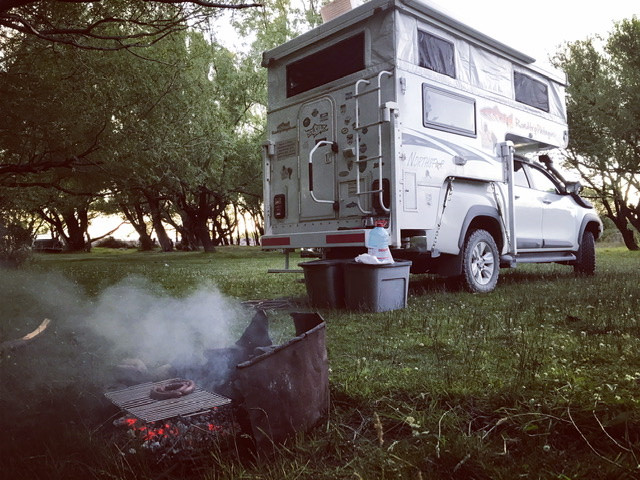
After making the circuit of several small shops to gather provisions, I found a quiet campsite next to the Rio Senguer. I fell asleep listening to the babbling water and dreaming of giant char.
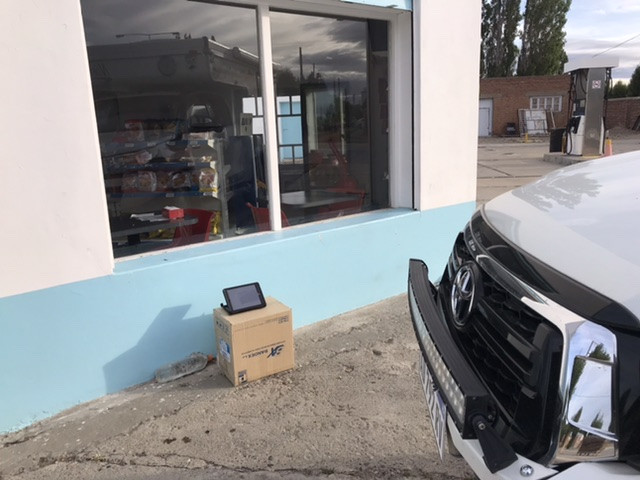
I woke extra-early in the morning to download 175 images to a file sharing program and showed up at Diego‘s gas station at 6 AM. The password entered, the download began. It was terribly slow. Diego showed up two hours later and asked how thing we’re going. I told him slow but it would get done. He bought me coffee and we conversed in our rough respective English and Spanish using the translator on the iPhone. I noticed he was wearing a G Loomis hat and asked: “Are you a fly fisherman?” “Yes”, he said, “I am.” He went on to tell the tale of how his Reddington flyrod had broken and he had no way to get it repaired. He produced the rod and, indeed, it was broken near the ferrule. We discussed how I might take it back to the states and get it fixed, but I didn’t know how I could get a return to him.
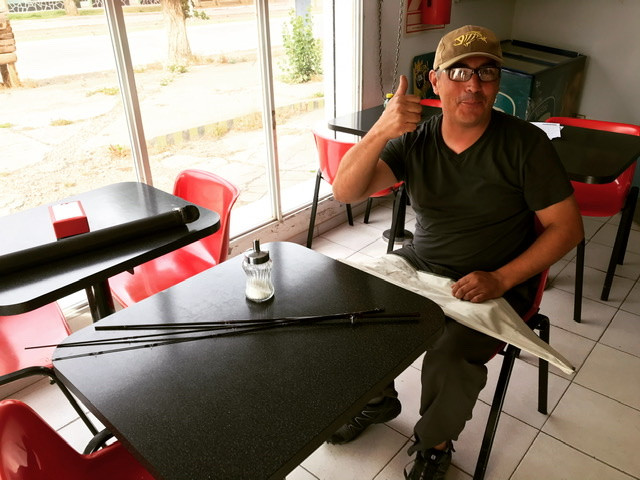
Diego began asking questions about Orvis fly rods and asked if they were any good. I said yes, they were excellent. It was then that it occurred to me that in the camper I had a Helios fly rod several years-old that I hadn’t used on this trip and would most likely replace upon my return with a newer generation of rod. Considering that this guy might have a huge phone bill for me crushing his Internet volume, I produced the rod and handed it to him. The astonished look in his eyes quickly turn to delight as he took it out and marveled at it. “I am very happy!” He exclaimed in English over and over. I figured it was the least I can do to pay forward, or back, some of the many kindnesses received on this journey.
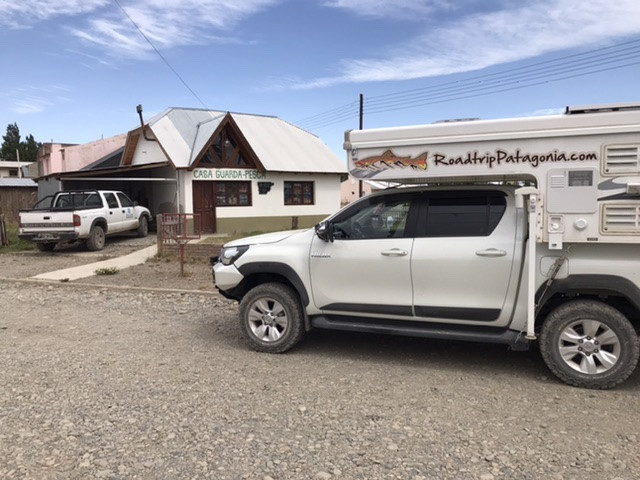
As the Internet download kept dragging on, and on, and on I figured there were served hours to be spent sitting there watching it happen. I excused myself from Diego and told him I was taking a walk through town. Before long I came to the door of La Guarda Pesca for the Río Senguer fishing district; these are the fish cops, the game wardens.
I went in to introduce myself and inquire. The wardens were very interested in my journey. They gave me a couple more fishing location options on their map of the local river system; places where I might catch a large fontanelle. Again, for the fourth time in two days, a pair of hands shot out in front of a person with palms held 24 inches apart. The suspense was becoming unbearable.
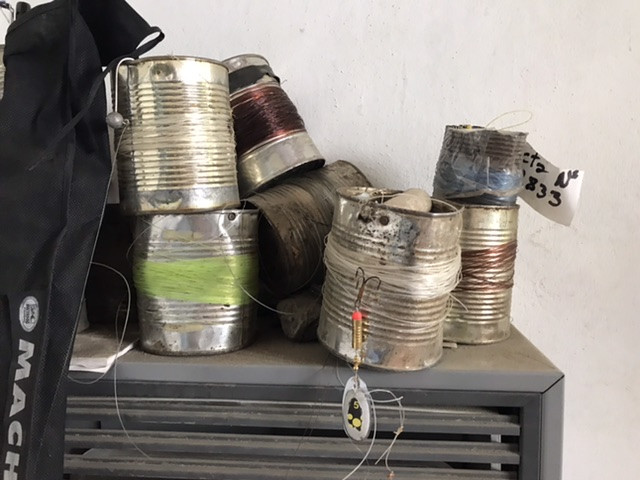
As I was looking at the map I noticed some strange-looking fishing tackle in the office; crudely made fishing reels made of cans holding heavy monofilament, heavy spinning rods, and various terminal tackle configurations made of nuts, bolts, and treble hooks baited with dried pieces of fish.
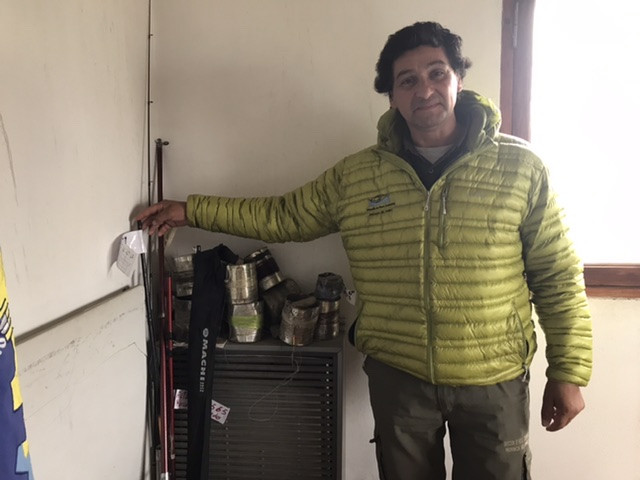
“Infracciones!” said the Ranger. Infractions, in English, meaning they had confiscated these crude pieces of gear from people fishing in flyfishing only, catch and release waters. They handed me a fishing regulation book from 2006 and said nothing has changed since then. They asked to see my license and recorded it dutifully.
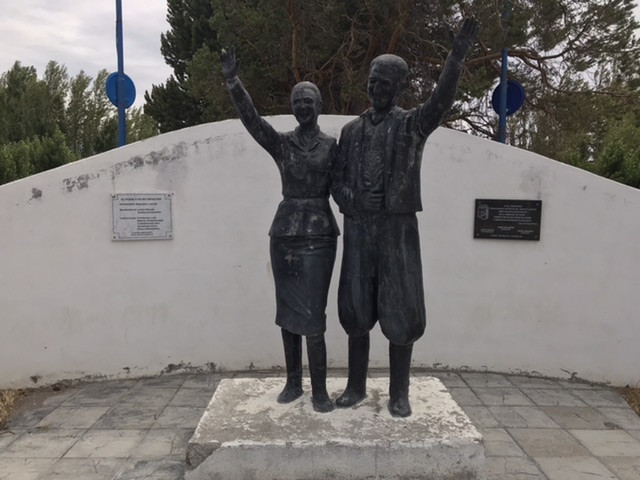
In short order I had walked The perimeter streets and crisscrossed the entire town of Alto Rio Senquer. One curiosity heretofore unseen was a statue of Juan and Eva Peron, the famous dictator & his wife widely credited with destroying Argentinas burgeoning economy and thus ascension into the first world order during his tenure following the second world war. The Perons created a form of populist unionism/socialism that still has a grip on the spine of the Argentine economy to this day. It must be the company I keep, but I’ve never met an admitted Peronist during my time in 14 visits to Argentina. Accordingly I am confident that there are no Peronists in the business classes of the country. Those describing the situation maintain there is a large class of people in Argentina that expect compensation for doing little to nothing, kind of an entitled, welfare class. Firing an employee loads an employer with substantial penalties paid to the terminated employee. All employees get a thirteenth month wage annually regardless of performance. Since voting is mandatory in Argentina Peronism has developed as a way to buy votes to keep in power. This past December the Peronists took power again after Argentina struggled four years with a reformist president that, unfortunately, couldn’t change long-entrenched politics in his short tenure.
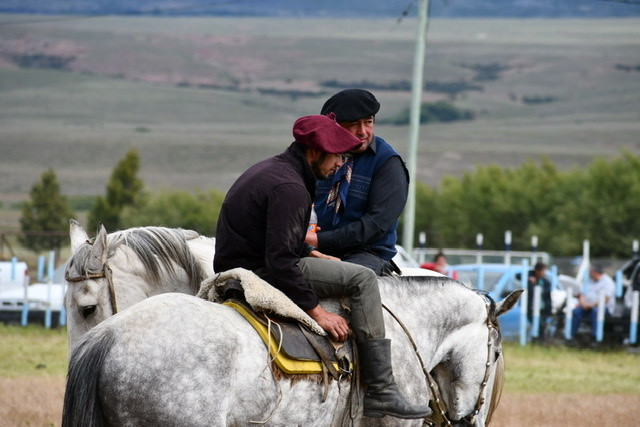
Back at Diego‘s gas Station, I checked the download process and found that only 75 out of 175 images had uploaded in a six-hour investment of time. I was getting pissed. They were giant Brook Trout to be caught and technology stood in the way. Lynnette called from Alaska and asked how things were going. I told her of my agitation and she simply told me stop pushing so hard and wait until I got back to the United States when the images could be uploaded on high-speed Internet. As I hung up the phone, I turned to the street and saw two gauchos riding on horseback down the paved road. Lynnette was right; give it up. This is not a high-tech country (that’s what we love about it). I stopped the upload, wrote to those promised the images, explained the the difficulty and that the images would have to wait. I added there were a giant char be caught and it was time to go fishing.
Jeremy had given me his notes verbatim from 20 years earlier. There were two ways along the Rio Senquer: the southern Road and the northern road. His notes said the southern road got extremely rough and eventually turned into an impassable two track. The Guarda Pesca had confirmed this. Yet, the southern road was the way Diego had recommended I go. A very timely telephone call came in from my friend Agustin, who exclaimed excitedly his surprise at seeing my location being at Río Senguer. He said he had a friend who owned two estancias on the upper lakes, and he had heard that the Rio Union, the river connecting Lago Plata with Lago Fontana, had excellent fishing for big Brookies. Looking at the map, and seeing that the road to Rio Union was the northern road and far-better improved; and that fact was also confirmed from Jeremy‘s notes; the way to go was settled. Time was limited that day and having a big-fat camper on the back of the truck would slow me down. The easier, northern road was indeed the best way to go.
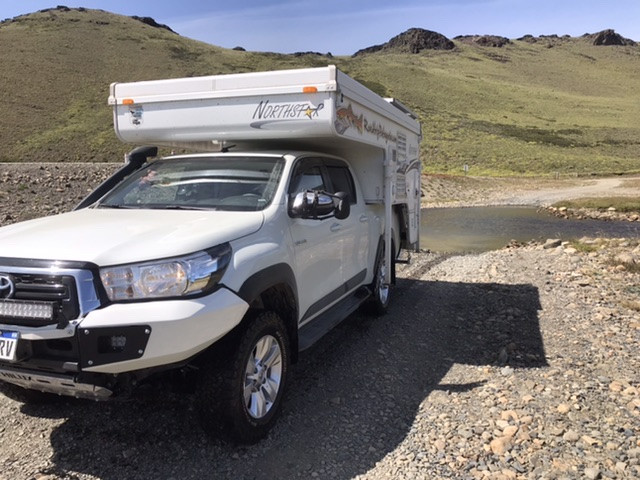
Bidding Diego farewell, I jumped in the truck and dialed in Lago Plata, which was 80 km away. The road was another torturous stretch of washboard and cobble–sized rocks but it was a beautiful ride coming into the Andes. A wind estimated it 60 km/h was on the nose of the truck. I watched the fuel economy plummet as I headed uphill. There was no traffic on the road as the grade narrowed into the familiar forest of thick Nires trees that began. Yes, I thought, this is Brook Trout country!
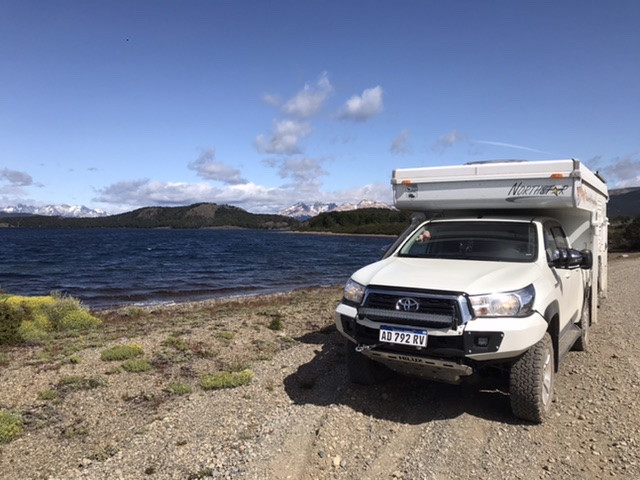
The road swung to the edge of a huge, deep lake crested with whitecaps.
With a shock I came to the end of the road to find a series of campgrounds and Cabanas. My bubble of a remote, wilderness experience thoroughly popped. There were people everywhere, camping and fishing. Some campsites had portable generators running beside them. I went to the absolute end of the road at Lago Plata to find the wind absolutely screaming and the outlet of the lake un-fishable. Besides, the outlet was surrounded by resort.
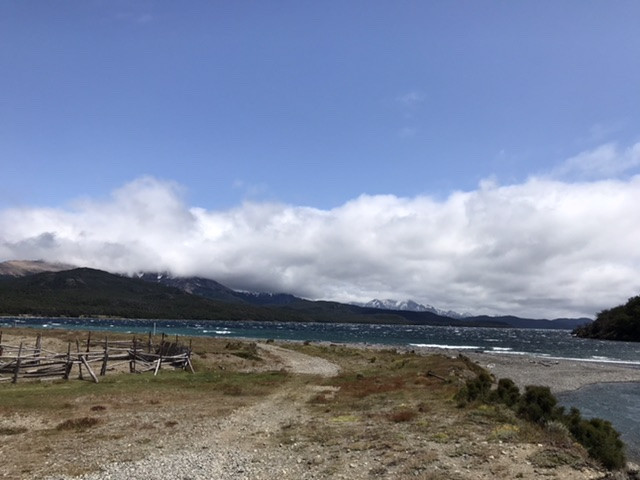
While the view, described by my unmet Argentine friend Chary, was indeed extraordinary, this was no place to fish. Reading back over Charlie’s notes, written in Spanish, I came to the conclusion that he must have access to a boat. I headed to the bottom of the river towards it’s entry point at Lago Fontana.
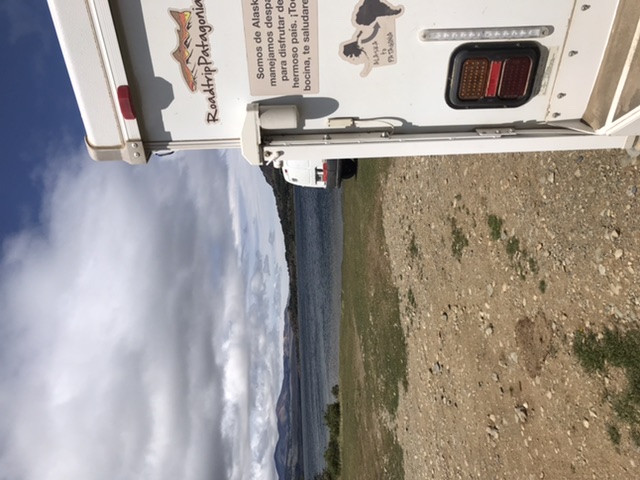
More campsites. And, worse yet, there was a van full of very rough-looking people, fishing the river next to a sign. The sign said: “fly fishing only, catch and release” in Spanish and there they were, swinging baited hooks into the water with strings and cans. While I would’ve loved the irony of getting that photo, I didn’t dare. They made me uneasy. I did take a photo of the back of their truck in secret, in case there was trouble. As I set up my tackle they were looking at me with a somewhat scornful look. I walked straight to them and gave them a cheerful greeting and asked permission to pass. They all lit up with cheery smiles and said “Passé, Passé!” and waved me by. Out of the corner of my eye I watched one of them change a babies diaper and throw it on the ground into a greater ring of trash they’d created. Perhaps these are the Peronists I’d heard about.
Using a sinking tip line, I tied on a conehead Muddler/Zonker pattern that had worked previously for Brook Trout.My first cast into the shelf at the bottom of the river produced 12 inch Brooke trout. While the fish could hardly fit the fly into his mouth, this was an excellent sign. I kept casting. The next cast produced a rainbow trout of about 10 inches. Further casts had small fish chasing and attempting to eat to the fly with no success. Action then stopped altogether. I went back to change to a floating line with a nymph rig. The Peronists were just leaving, and, as I walked by, I marveled with sadness at the now-grown pile of trash.
The nymph rig didn’t do anything until I moved into the river and, after about an hour of fishing, came to a shallow area with a weedy bottom.
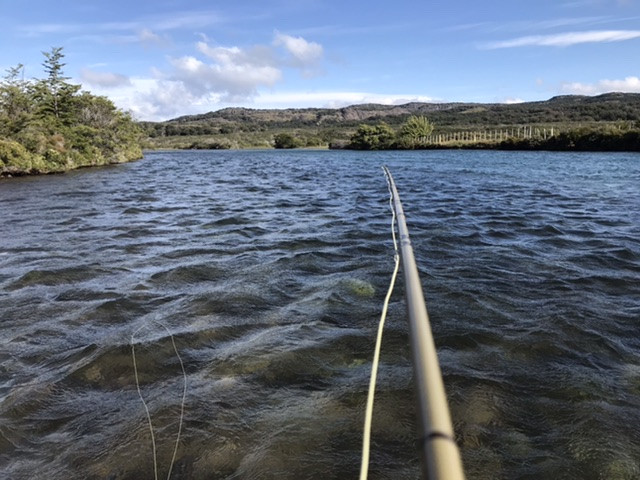
I’ve heard it said repeatedly that the best way to fish a big river is to look at it like a small river. Suddenly, I was on an imaginary spring creek. I tried dead drifting the nymphs to no success but when I saw a small fish hit my orange strike indicator, I remember my buddies in Alaska, the Dolly Varden, which attack anything skated across the surface that has a bright color. By then, the wind was absolutely ferocious coming down the river and I needed a break. I went back to the camper and found a sheltered spot out of the wind and set up camp for the night. Looking at the rod I’d been casting I noticed it was an eight-weight. No wonder it cast like a broom stick with the six weight line. Screw it, I thought, if I’m going to fish a small creek I’m gonna do it the right way.
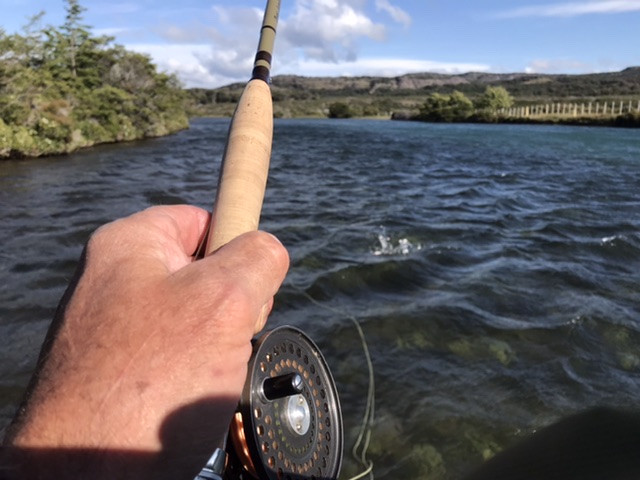
I picked out my favorite, vintage Orvis four weight fiberglass rod with my old, trusty CFO fly reel and tied-on tiny red Leach that looked more like a jig.
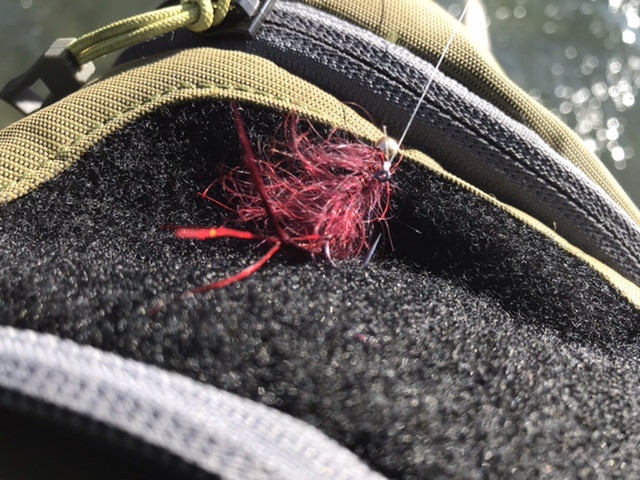
Back at the river, I went to the top of the long stretch of weed-covered bottom and began casting, ignoring the hurricane-like winds. In short order, I was being struck on virtually every cast.
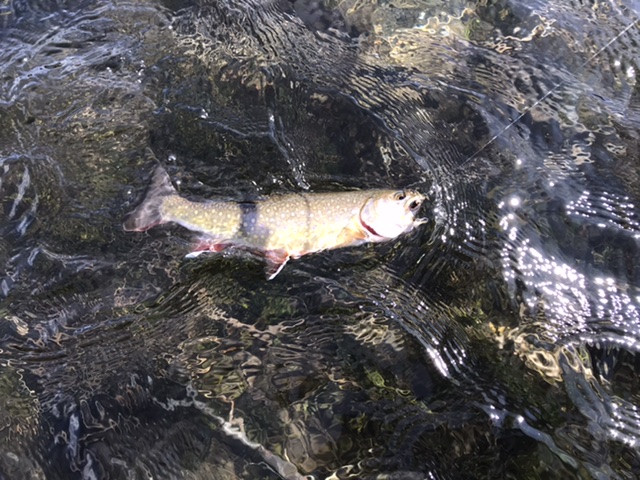
By the time the weed patch ended 200 meters down river I had caught and landed 30 Brook Trout.
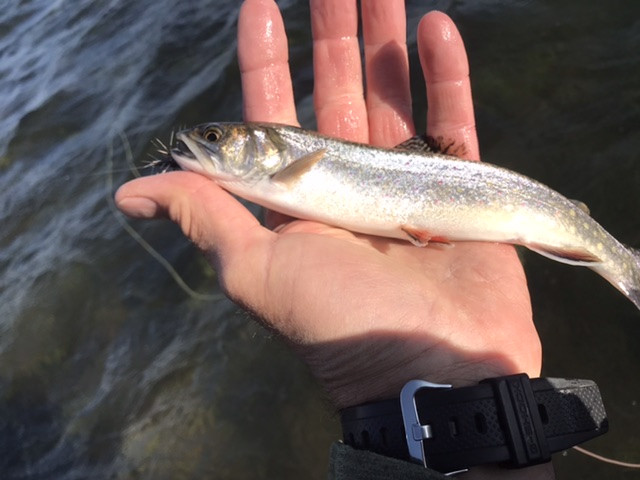
All of them would’ve fit into a 1 Liter bottle.
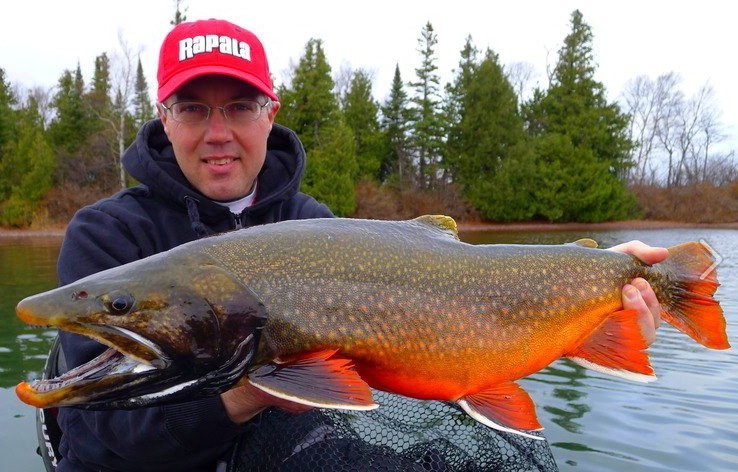
The mission in search of giant Patagonian char was over. The above image was stolen from the Internet. I hope the guy doesn’t mind. I picked it as a demonstration of what was in my minds-eye the days preceding. That’s a beautiful fish, but I wasn’t getting any of that. As often is the case in life, what we seek and what we find are two different things.
With mirth I thought back to the series of people holding their hands apart 24 inches. I could only smile. One of my obsessions had caught me again and took me on an adventure. I thought back to the title of an obscure Kris Kristofferson song that had influenced me to undertake this four month journey. The songs title is “I’d Rather Regret Something I Did Than Something I Didn’t Do.” No regrets, in this instance, either way.
